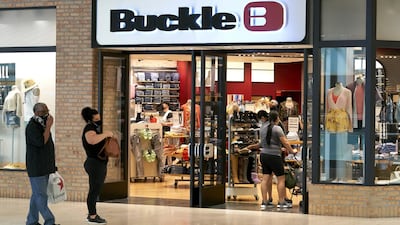During the coronavirus lockdown, a particular meme has been doing the rounds on Instagram and Twitter.
It shows a woman in a pink ball gown, complete with tulle train billowing out behind her. She’s not standing on a glitzy red carpet. She is in a supermarket produce section, clutching a bunch of carrots in one hand and reaching for a red pepper with the other.
The image encapsulates how some consumers feel: after being cooped up at home for months, they can’t wait to finally have an opportunity to get all dressed up again.
But for many others, what they wear, how they shop and which products they buy will be forever altered by the pandemic. The Covid-19 outbreak, which has tragically infected more than three million people and killed more than 250,000, has also struck at the heart of consumerism around the world.
With a quarter of a million stores closed across the US at the height of the lockdown, according to research group GlobalData, the ability to purchase, long a symbol of affluence and status, is in peril. Never has materialism seemed so emasculated.
First of all, there’s the immediate economic impact. With millions of workers temporarily furloughed and laid off, they will be reining in their spending. If these become permanent job losses, the effect will be even more severe. Conspicuous consumption is going to look ugly for a while.
Then there’s the slow and incremental process of coming out of lockdown. Even individuals who have kept their jobs and full salaries may make longer-term changes to their spending, as it will be some time before they feel comfortable visiting crowded malls and dining out in restaurants again.
With social distancing potentially staying in place for up to two years, according to KPMG, this could mean far-reaching consequences for the operation and physical design of stores. For example, stores might have to require appointments for visits, offer more checkout free locations and even rethink facilities such as changing rooms. Who wants to pick up discarded garments when the world is emerging from a pandemic?
So far, there are some encouraging signs coming from China, where consumers emerging from lockdown seem to be embracing shopping once more. PwC estimates that as of early April sales at non-food retailers were at 50-80 per cent of their pre-crisis levels. In luxury, the recovery has been even more extreme: a Hermes International flagship store took in $2.7 million (Dh9.91m) when it reopened in Guangzhou in mid-April, believed to be a record daily haul for a boutique in China, according to fashion trade journal WWD. LVMH said some of its big brands on the mainland had seen 50 per cent increases in sales in April compared to the previous year.
This phenomenon is being called “revenge spending", a phrase first coined to capture the desire for consumer goods unleashed in China during the 1980s, after the poverty and chaos of the Cultural Revolution. At the moment, Chinese shoppers are flush with cash after cancelled travel and events. However, this demand may not last, especially as the number of people allowed in boutiques at any one time is limited and initiatives such as temperature testing have been put in place.
The bigger impact of this crisis, then, may be a shift in what consumers choose to buy. For example, the outbreak has hit something we largely take for granted: our health. That could mean spending even more of one’s income on private health insurance or buying products that help boost immunity.
Despite criticisms that so-called self-care is the expensive preserve of millennial hipsters, society’s desire to ensure it doesn’t get sick will likely turbocharge demand for these products.
The pandemic has also fostered a renewed sense of community. This plus the inability to travel very far could encourage spending in more local shops and on brands with strong regional identities, as opposed to the big retailers who may have had empty shelves or struggled to deliver online orders during the crisis.
One sector poised to suffer tremendously going forward is clothing. Most consumers have effectively skipped a fashion season. Conferences, parties and weddings have been cancelled, so we’ve simply needed fewer new clothes. There may be some pent-up demand when consumers rediscover their freedom, but for many, essential grooming such as getting a haircut will take precedence over buying a new outfit.
During the prolonged shutdown, there will be some retailers that consumers simply don’t miss and therefore may not return to. And how brands behave when the chips are down will also determine how customers react to them in the future.
Some have acted particularly well, adapting their offerings to meet changing needs. For example, luxury goods groups, including LVMH, Kering, Prada, Burberry Group and Ralph Lauren, repurposed their facilities to produce protective equipment such as hand sanitiser, masks and gowns. This nimbleness won’t be forgotten.
Whether out of necessity or choice, shoppers will want goods that are appealing – and, after a health scare, make them feel good – but are priced at a level they believe is appropriate. This doesn’t always mean the cheapest, but it does mean a perceived sense of good value for money.
Andrea Felsted is a Bloomberg Opinion columnist covering the consumer and retail industries
* Bloomberg

